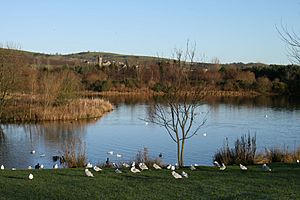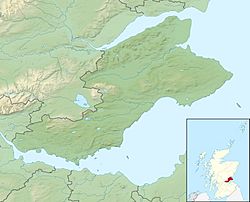Birnie Loch facts for kids
Quick facts for kids Birnie Loch |
|
|---|---|
 |
|
| Location | North East Fife, Scotland |
| Coordinates | 56°18′4″N 3°9′25″W / 56.30111°N 3.15694°W |
| Type | artificial lake |
| Basin countries | United Kingdom |
Birnie Loch is a special place in North East Fife, Scotland. You can find it near where the A91 and B937 roads meet. It's not a natural lake! It was actually made by people. It used to be a big hole where sand or gravel was dug out. Later, this pit filled with water, creating the loch we see today.
How Birnie Loch Was Made
Birnie Loch was once a large pit where companies dug out sand and gravel. When they finished digging, the company decided to give this flooded pit to the local government. They thought it could be a great spot for everyone to enjoy.
To give this new water body a name, they held a competition. A local schoolgirl came up with the name "Birnie Loch," and it stuck! This was the first time a place like this in the area was given back to the community.
A Home for Wildlife
Birnie Loch has grown into a lovely small lake. Many different kinds of wildlife now call it home. You can find all sorts of birds, fish, and tiny water creatures living there. Lots of water-loving plants also grow around its edges.
Nearby, there are other similar water areas called the Gadden Lochs. These have become a special place for wild birds, with a hut where people can watch them. Birnie Loch is also a protected area for wildlife. However, unlike some other nearby spots, you can still walk along its banks. This is different from places where fences are put up to protect birds that are nesting.
Awards and Recognition
Birnie Loch has been recognized for how well it was changed from a mining pit into a beautiful natural area. It won several important awards:
- In 1994, it was the Supreme Winner in the Scottish Environmental Regeneration Awards.
- In 1997, it received the UEPG European Restoration Awards.
- In 1998, it won the Quarry Products Association Restoration Award.
These awards show how successful the project was in turning an old industrial site into a valuable place for both people and nature.


